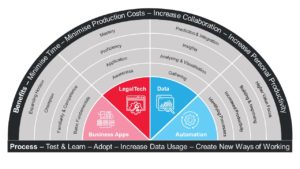Emails, text messages, phone calls, voicemails, Zooms, Teams chats, Slack messages, calendar alerts, and workflow pings, the amount of communication we receive daily is continually increasing. While each technology serves its purpose and is carefully designed to enable greater efficiency and collaboration, the onslaught faced every day can be counterproductive. The volume leaves employees overwhelmed, anxious and without the cognitive bandwidth to deliver optimally at work.
Add to these communications channels the ever-increasing pace of delivery and demand for collaboration and it’s easy to see why there is a constant rolling eruption of technologies launched, designed to tackle productivity. But the answer does not lie in the implementation of yet another tool or technology.
In order to thrive (not just survive) in this era, businesses need to think differently, do things differently and deliver differently. True digital transformation is not just about the technology. Adding more technology and more tools isn’t enabling greater advancement. It’s about the entire ecosystem transforming – data, systems, processes and people – to achieve improvement at scale for an organisation’s people and clients.
“When digital transformation is done right, it’s like a caterpillar turning into a butterfly, but when done wrong, all you have is a really fast caterpillar.”
George Westerman, MIT Sloan Initiative on the Digital Economy.
Digital transformation is about organisational mindset as much as it is about the tools used, processes followed, and productivity gains achieved. When done well, it removes time-consuming, manual, and often paper based activities, and replaces them with digitised, auditable, collaborative systems that provide a more efficient and transparent employee and client experience. Removing friction points boosts productivity and frees up time for you to focus on the things that matter most, delivering greater value for your clients.
Just as it has done across multiple sectors and global markets, digital transformation has accelerated within the legal industry and clients are increasingly expectant of firms to be on the same transformation trajectory as they are, working smarter rather than harder. But how does an organisation retain clear line of sight of their trajectory on their digital transformation journey?
“Learn how to see. Realise that everything connects to everything else.”
Leonardo da Vinci.
Successful digital transformation is not only about implementing technologies. It also involves the alignment of three core pillars that together create a complex ecosystem of capabilities. These pillars are data; systems and processes; and people. Each of those pillars are critical to the implementation of any new technologies that are part of your organisation’s transformation journey.
Data is an influential asset that needs to be carefully nurtured and curated. I’ve written before about why I love data and the power it has to influence policy, improve service delivery, guide strategy, unlock an otherwise hidden trend and even help shift behaviour.
But it’s the components relating to systems and processes and people where transformation can often come unstuck. The pace at which employees need to increase their digital capabilities needs to align to the speed at which organisations are transforming. Digital literacy takes time and doesn’t happen in a vacuum. It requires dedicated planning, education and training, practical application, and a method of measurement so an organisation has visibility into the level of maturity being reached.
A road map tells you where you’ve come from and where you’re going, but not how to get there.
At KWM we have designed a digital literacy maturity model that acts as a framework for designing implementations and measuring movement along the maturation journey. It provides a road map for our enablement, benchmarks for capability and aspirational behaviours that will be attained as your organisation progresses.

This model does not act as a directive, nor does it explicitly outline how to move through the levels. Rather it is a tool that helps measure and track the flexibility of the organisation and its continuous improvement in digital literacy. Working with the model begins with an assessment of what level the organisation is currently performing. Once the level has been determined, you review the level above to establish what capabilities need to be learnt next and prioritise strategic goals for improvement and progress. This prioritisation of learning and the focus on the people adopting the tools, technologies and associated processes, is the key benefit of using a maturity model.
The digital literacy maturity model isn’t about reaching an ‘end state’, it’s about the continued focus on the list of things you need to work on to improve. It’s about the continuous improvement mindset and the ever-evolving movement forward along your organisation’s digital transformation journey.







